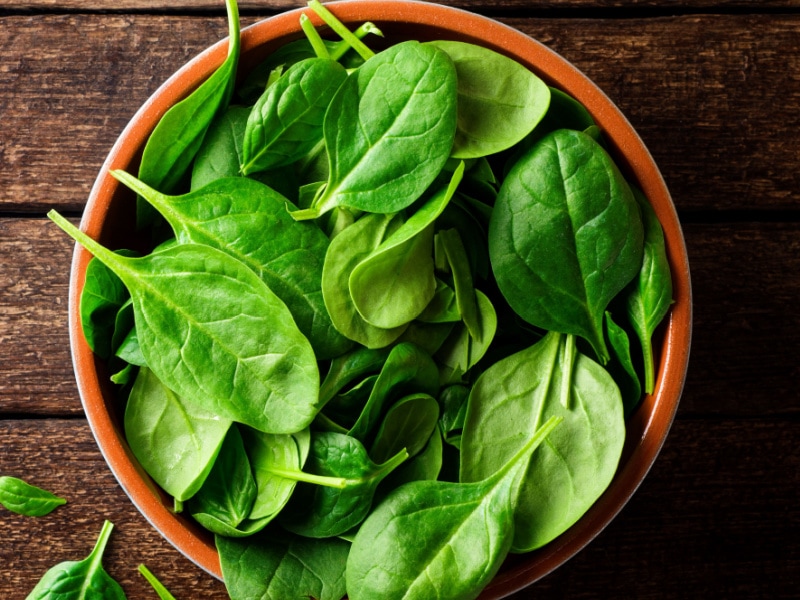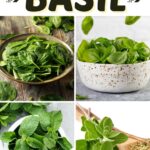Try one of these 10 substitutes for basil when you don’t happen to have any.
Because basil is one of those herbs that likes to take center stage. So you can’t just skip it altogether!

Substitutes for Basil
Basil’s unique flavor toes the line between sweet and peppery with just a hint of minty goodness.
And whether you’re making homemade pesto, Italian classics, Mediterranean fare, or a simple Caprese salad, you need basil.
That said, if you’re fresh out of this signature herb, these substitutes for basil work in a pinch.
While there is no genuine replacement, I’ve gathered a few substitutes for basil (both dried and fresh) that come pretty close!
Dried vs. Fresh Basil
Fresh is always best, and that’s certainly true when it comes to basil.
Dried basil has a denser and more savory flavor profile, and it loses a bit of its patented sweetness when dried.
The use of dried and fresh basil always depends on the recipe.
If it’s a seasoning in a tomato sauce, you can get away with dried.
For a summer salad, however, dried basil just won’t cut it.
I’ve divided these substitutions into two categories: dried and fresh.
They’re not identical replacements for basil, but they capture some of the textures and notes from this complex herb.
Dried Basil Substitutes
Using dried basil in heavy sauces and Italian dishes is a great way to add depth of flavor.
These dried herbs work in a pinch if you are out of dried basil.
They aren’t carbon copies of dried basil but offer similar earthy and minty notes to accentuate your recipe.

1. Italian Seasoning
If you think you’re out of dried basil, take a second look in your spice rack!
Italian seasoning is one of the best substitutes for dried basil because most blends contain basil, among other Italian herbs.
Italian spice blends typically contain thyme, oregano, rosemary, pepper, parsley, and basil.
Be careful when using dried Italian spices because the flavors are potent.
If your recipe already calls for rosemary or thyme, cut down on the extra spices when swapping basil for Italian seasoning.

2. Rosemary
Dried rosemary is a flavorful, needle-like herb that packs in the flavor.
While the flavors from fresh rosemary don’t precisely mimic the savory sweetness of basil, it captures the warm peppery flavors of basil.
When layering flavors and spices, rosemary works best in sauces or marinara.
Those somewhat smoky and savory flavors taste amazing when paired with buttery potatoes.

3. Sage
Sage and basil have a lot in common.
They’re both members of the mint family and offer very subtle minty flavors.
While basil tastes sweet and savory, sage lands more in the savory category.
Dried sage is savory and robust with bright, earthy flavors accented with mint and lemon.
Like basil, dried sage flavors don’t get lost in heavy sauces.

4. Thyme
Thyme is a strong herb that works best in heavy sauces and marinara.
While every other dried spice works in a 1:1 ratio, you must be careful with this very potent herb.
Even in a heavy marinara sauce, it’s always better to use half as much thyme as fresh basil.
Thyme has a fragrant, earthy flavor with a kiss from mint and lemon.
Since the flavors of thyme are more potent than basil, be sure to taste as you go.
This will ensure that this herb doesn’t take over the entire dish!
Fresh Basil Substitutes
In crispy summer salads or raw Mediterranean dishes, fresh is always best.
However, they work well if a menacing squirrel dug up your basil plant (like they do in my herb garden!) or the grocery store is out of fresh basil.
These alternatives are as close as you can get to the real deal.

5. Mint
Since basil is a member of the mint family, it’s no surprise that fresh mint is a wonderful alternative.
However, unlike basil, fresh mint is a one-note herb. It delivers fresh, minty flavors but not much else.
And mint has a way of completely overpowering a raw dish. When swapping basil for mint, use it in a 1:4 ratio. As always, taste as you go.
You can always add more mint if you like, but removing it from the recipe is more complicated if you add too much!

6. Oregano
Fresh oregano mirrors the taste and texture of basil to a T. It has a bold peppery flavor, similar to basil, but it isn’t quite as sweet.
It works great in raw dishes like salads or raw Mediterranean dishes, but beware- a little goes a long way!
Oregano likes to overpower the other flavors in your dish, so add oregano slowly.
Start with 1/4 as much oregano, taste, and add more if needed.
It doesn’t hit the sweet notes of basil, but its peppery and lemon notes add a ton of fresh, earthy flavors.

7. Parsley
Parsley is abundant in my herb garden and relatively affordable at the supermarket.
And luckily, it makes an excellent alternative to basil.
The flavors of parsley are pretty mild and toe the line between sweet and savory- just like basil!
Fresh parsley is such a great alternative to basil that you can even use it as a substitute in pesto.
If you worry that more potent herbs will overpower the flavors in your dish, you can never go wrong with fresh parsley.

8. Spinach
At face value, spinach looks exactly like fresh basil.
It has a near-identical shape and textures, but the flavor of fresh spinach is a bit different.
Raw spinach has a very mild sweetness when consumed raw, similar to basil, sans the earthy, peppery bite.
It makes a wonderful alternative when used in fresh garden salads, and you can even use it in a Caprese salad.
The textures and sweetness are there, but you lose the complex depth of flavors.

9. Tarragon
Tarragon flavors are light and delicate and have much in common with basil.
It boasts a mild licorice flavor like basil, with subtle notes of citrus and peppery flavors.
What makes tarragon a fantastic substitute is that it also straddles the line between sweet and savory.
However, since the flavor of tarragon is mild, you may need to use a little more than you would fresh basil.
It’s an excellent alternative for salad dressings or raw salads, thanks to its light and never-overpowering flavor.

10. Arugula
In uncooked dishes and salads, arugula is a great swap. It has a similar texture to basil and mimics its earthy, peppery flavors.
The only downside to using fresh arugula is that it isn’t quite as sweet and refreshing as fresh basil.
The flavors are very peppery to the point of bitterness. So if you’re using fresh arugula, play around with different greens.
A combination of arugula and spinach is a great way to get the sweet, earthy depth of flavor without the fresh basil!
Check out my post “What is arugula?” to learn more.











